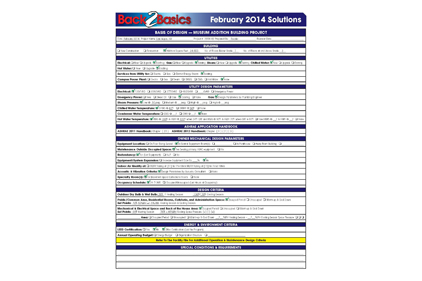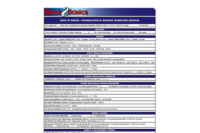As for the HVAC engineer, he will take the program information and craft a Basis of Design (BofD) using the suggested BofD template on Page 2 of this B2B. For this month’s test, we have documented the BP for a museum building addition. On page 2 of this B2B, the reader shall complete the BofD by filling in the pertinent data drawing upon the BP information provided and from pertinent reference documents such as local weather data design criteria, etc., for Las Vegas, NV. Find the answers to the BofD here.
This museum addition is to be a 24,000-sq-ft, two-story with a basement below grade. The building addition will be open to the public on the first and second floor, while a private collection in a 800-sq-ft climate-controlled room will be located in the basement along with the administrative space. Utilities will be provided from the existing building mechanical and electrical infrastructure along with the building’s city water source.
The existing electrical service was previously sized to accommodate this addition, as was the heating system. City water capacity is also adequate for the domestic water needs. Additional air-conditioning equipment will be needed for this new project.
The HVAC electrical requirements shall be 120/1/60 for motors less than .5 hp and 480/3/60 for motors .5 hp and larger. The additional heating and reheat capacity will require 1,728 MBH from the existing steam boilers and steam-to-hot water heat exchangers to serve the individual HVAC equipment, humidifiers, individual room fan coil units, and to serve VAV terminals providing HVAC to the occupants.
A high-efficiency centrifugal chiller and associated cooling tower will be added to carry the cooling. Public space and administrative space will have enthalpy airside economizer, while the closed collection space shall be fixed minimum outdoor air. Air filtration shall be MERV 11 pre-filters and MERV 15 final filters, chilled water coil, and VFD fans to provide supply air VAV to the building public spaces and constant volume to the non-public space. There is standby electrical that will be provided from the existing emergency.
The HVAC design of this building addition shall be based on state and local codes as well as the design engineer referring to the ASHRAE 2011 Application Handbook chapter 23 Museums, Galleries, Archives, and Libraries for basis of design requirements. The design engineer may also draw upon other documents at the end of Chapter 23-References for other specific design considerations.
When beginning to shape the BofD, the engineer should take into account the ASHRAE recommended HVAC system analysis and selection process found in chapter one of its 2012 Systems and Equipment Handbook and continue on with the BofD data collection by reviewing chapter two “Decentralized Cooling and Heating” and/or chapter three “Central Cooling and Heating” to determine the optimum HVAC systems for this BP.
The design engineer, in conjunction with the building owner and the architect, has finalized the HVAC system to include a closed-loop hot water heating system along with closed-loop chilled water cooling, adding steam humidification for a select few rooms.
While the HVAC system could be designed for occupied-unoccupied modes of operation, the owner has requested these systems operate 24 hrs/day, year-round. The hot water heating system shall be an outdoor temperature compensated system (160?F HWS & 120?F HWR at 28?F outdoors and 90?F HWS & 70?F HWR when greater than 60?F outdoors). The chilled water system shall be 42?F CHWS & 56?F CHWR and also operate year-round. Occupied space shall be maintained at 72?F with 50% RH +/- 5% rh. Equipment room and back-of-the-room support areas will be maintained at 68?F with no humidity control in the heating season, and at 78?F and a not-to-exceed 65% rh during the air conditioning season, while these support areas will be maintained at 0.005 negative pressure.
There will be no specialized energy and/or environmental program criteria, and the owner has not requested any other special conditions as part of the BP. The reader is directed to the Facility File for the Owner’s Building Program Annual Operating Budget and Operating Program.
As the design phase for this BP goes forward, the BofD should be routinely referenced and updated based on changes in the BP, as well as changes and/or enhancements to the HVAC design.








